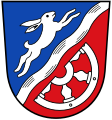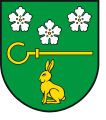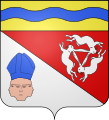Hare (heraldic animal)

As heraldic animal , the hare is a common figure in heraldry .
Whether hare or rabbit depends on the position in the coat of arms. The hare can be recognized by its long, often raised ears. The elongated body shape is also required. The animal is shown running fast. Often only the head is in the coat of arms, occasionally in two or three times the number. Three animals are also placed in a three-pass . This is based on the tracery of the so-called rabbit window in Paderborn Cathedral .
The hare can also mutate into a rabbit in the coat of arms . But even then it should be described as such. It can be recognized by the typical sitting posture as the main difference to the hare and its long, often erect ears.
The basic alignment of both is, as with the other heraldic animals, to the heraldic right . Heraldic tinctures are not limited in the hare or rabbit. Sometimes a turnip or other nibble is placed in the forelegs. This must also be reported in the description of the coat of arms .
Both can appear in the coat of arms , but also in the upper coat of arms . A specialty is the fish-tailed rabbit. In this fictional character, the rear part of the hare is replaced by a fish tail.
Examples
Fishtailed in the Prochowice coat of arms
Kahl am Main : running hare, referring to sand hare ( local name )
Königswiesen : Growing in natural color
Hasenkopf in the coat of arms of Reilingen
Sanitz : Golden and sitting
- Three rabbits coat of arms
Example of a talking coat of arms
Since the hare is suitable for the family name hare as a talking heraldic animal , it can be found with this intention on many civic coats of arms. The pronunciation is more decisive than the spelling. So it is also possible: Haase, Hahse, Has or Haas.
Haßloch (Rüsselsheim am Main) : Above in the coat of arms, the Mainz wheel below is a running hare.
Web links
literature
- Walter Leonhard : The great book of heraldic art. Development, elements, motifs, design. Bechtermünz, Augsburg 2003, ISBN 3-8289-0768-7 .












